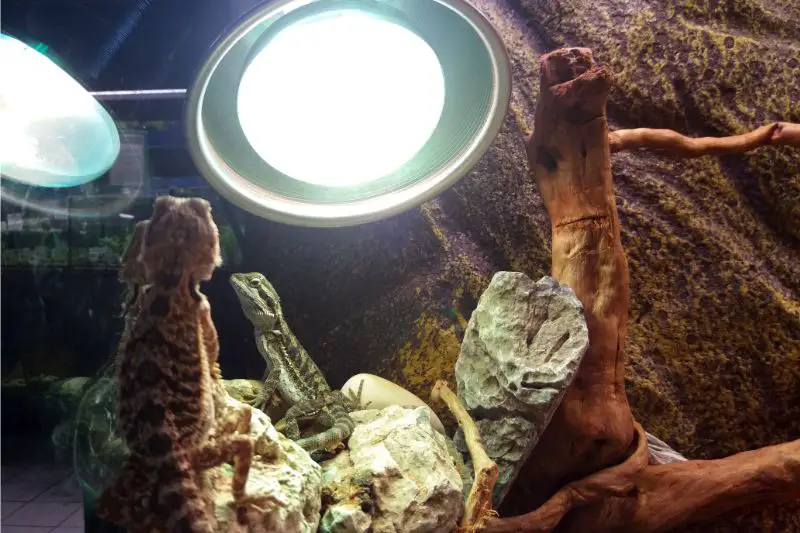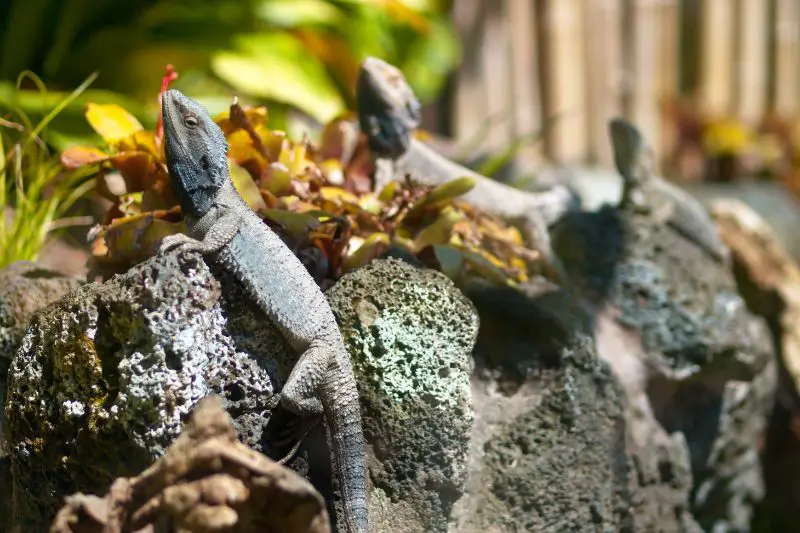This page may contain affiliate links that allow us to make a small commission from qualifying purchases (at no extra cost to yourself). We appreciate your support.
As a devoted pet owner, I understand the significance of maintaining the ideal temperature for my pet reptile’s well-being. It’s amazing how their metabolism and well-being can be directly related to the temperature in the vivarium, which is why it is so important to know the best placement for a vivarium thermostat.
Vivarium thermostat probes should be placed in the center of the tank, in the warmest, basking section. This will allow the reptile’s owner to monitor maximum temperatures and ensure the enclosure does not become overly hot. The pet owner may also choose to monitor cooler sections of the vivarium.
Well, fear not, fellow reptile enthusiasts! You’re in luck because there’s no need to crack your head thinking about thermostat placement. I’ve got you covered with some helpful tips on how to monitor vivarium temperatures like a pro and keep your cold-blooded friend feeling comfy all year round.
Where Should you put the thermostat in a Vivarium?
The thermostat in the vivarium should be located close to and beneath the heat lamp to ensure that it is easy to monitor and adjust. Keeping the thermostat probe under the heat lamp towards the center of the vivarium will help with fast and accurate temperature checks and adjust the reptile’s environment quickly.
If you’re using a heating pad outside your vivarium to provide your reptile friend with some extra warmth, there’s one crucial thing to keep in mind: safety.
To ensure that the heating pad doesn’t get too hot, it’s essential to plug a thermostat into it. This way, you can maintain a safe temperature range for your reptile friend and avoid any overheating mishaps.
When it comes to the thermostat probe placement, there’s no better spot than beneath the heat lamp in the basking area. This will give you an accurate reading of the temperature and help you gauge how warm your pet reptile is feeling.

Believe me, you don’t want to miss the sight of your scaley buddy basking under the heat lamp, with the thermostat right by their side. It’s a moment of pure joy that’ll warm your heart and make all the hard work worth it.
Now, here’s a pro-tip: avoid placing the thermostat probe in a spot that’s hard to read or easy to forget about. Placing it behind foliage or other decorations in the vivarium may obscure your view of the reading, making it harder to monitor the temperature.
So, make sure you have a clear view of the thermostat probe and keep it in a spot where you won’t forget to check it regularly. Trust me, your scaly friend will thank you for it!
My top recommended thermostat for smaller animals in a vivarium would be the Zoo Med ReptiTemp RT-600 thermostat on Amazon. Its budget friendly, great for frog or gecko vivariums, and works well with heating pads
If you have larger animals in your vivarium such as snakes, iguanas, or any other larger lizard, then I would recommend going with the Vivarium Electronics VE-300 Thermostat on Amazon. Its more expensive then the Zoo Med option but it is well worth it. The Vivarium Electronics thermostat comes with all the bells and whistles you could imagine and will make sure your tank environment is keeping the temperatures you designated and your pets safe.
Why is it Important to Measure Vivarium Temperatures?
Did you know that reptiles are cold-blooded creatures? That means they can’t regulate their body temperature on their own and rely on the temperature of their environment to stay warm and active.
If the air around your scaley friend is too chilly, they might feel sluggish, lose their appetite, and generally not be as happy or healthy as they should be.
Keeping your reptile’s vivarium at the right temperature is essential to their well-being, and some species are more sensitive than others.
So, it’s vital to monitor their environment closely to ensure that they’re not too cold or too hot.
If you’re wondering where to place the thermostat probe in the vivarium, there’s no better spot than the warmest, basking section. This way, you can quickly check whether the temperature is just right or needs some adjustment.
However, some reptile enthusiasts might be wondering if it’s possible to place thermostat probes elsewhere in the vivarium.
While it’s possible, it might not be the best idea since the reading might be harder to see or forget.
So, keep a close eye on the temperature in the vivarium and make sure your scaley buddy is feeling cozy and comfortable. With a little love and care, your cold-blooded friend will be happy, healthy, and thriving!
Can I Use Multiple Thermometers in My Vivarium?
It is a common practice to place multiple thermometers in a vivarium to ensure that the tank is neither too hot nor too cool. Some reptile owners choose to place a second temperature probe in the coolest parts of a vivarium, to ensure temperatures are not too low.
When reptiles cool down excessively, they can become sluggish, lose their appetite, get depressed, or become reclusive.
Therefore, making sure that your vivarium is not too cold for your new friend is an important part of reptile care, as is ensuring that they are not too warm.
If you do discover that the coolest parts of your vivarium are too cold for your species of reptile to enjoy or be comfortable in, adjusting your heat sources and airflow are both possible solutions.
Measure both the warmest and the coolest parts of your vivarium to strike a healthy and safe balance for your reptile.
How Can I Secure My Vivarium Thermostat?
Most vivarium thermostats are wired, and you’ll need to carefully tape down any wires so that your reptile does not become entangled and does not chew on the wiring.
Tape the thermostat wires down securely and position the thermostat out of the way of any foliage, logs, or other barriers. Make sure the display is unobscured by tape, easy to read, and away from direct sources of water or moisture.
So how warm should your vivarium be? Is there an ideal temperature for all reptiles, or is every species different?
Keep reading! This next part is important!
How Warm Should My Vivarium Be?
The ideal temperature of your vivarium will depend upon the species that you have in the tank. The lowest safe temperature for many reptiles is about 72° F, and the maximum safe temperature will depend upon the species of reptile you own.
For example, bearded dragons prefer basking temperatures of 100 °F, whereas a blue-tongued skink needs a maximum basking temperature of 90 ° F.
Be sure to check thoroughly to understand what temperatures are safest for the species of reptile in your vivarium.

It’s essential to keep in mind that you should not mix different species of reptiles within the same vivarium. Mixing species with different temperature needs and temperaments can cause health problems and can lead to unsafe conditions for your reptiles.
Keep each species in a separate vivarium with unique temperatures, habitats, and species-specific accommodations.
How Can I Keep my Vivarium Sufficiently Warm?
If you want your reptiles to be happy and healthy, it’s crucial to ensure that your vivarium has good airflow.
You can achieve this by strategically placing your plants and shade to maximize airflow while preventing foliage from becoming too crowded on one side of the tank.
Adding natural wood and plants to your vivarium is a great way to regulate temperatures naturally. Unlike artificial plants, natural materials absorb heat differently and more evenly. Plus, natural plant life creates an oxygen-rich environment that your reptile will love.
To make sure your reptile has a comfortable space to live in, ensure that your vivarium has enough shade and exposed surfaces. This way, your pet can enjoy a cool shelter and a warm basking area.
Replicating your pet’s natural habitat is crucial for helping it feel at home and allowing the ambient temperature to regulate itself naturally to an extent. For instance, heat behaves differently in a dense rainforest than in an arid desert.
Final Thoughts
You made it reptile lovers!
Let’s summarize how to keep our scaly friends cozy and safe.
When it comes to thermostats in your vivarium, it’s all about location, location, location. The ideal spot is right in the center of your tank, near the basking area.
That way, you’ll know just how toasty your pet is when they’re catching some rays. And for those cooler spots, a secondary thermostat probe can give you the lowdown on the chillier areas.
Now, when it comes to housing multiple reptile species, remember: they’re not roommates, they’re not friends, they’re not buddies.
Keep them separated in their own private vivariums with the right temperature and environment for their species. Trust me, they’ll thank you for it.
And speaking of temperature, it’s essential to know what your specific species needs. Do your research, and don’t be afraid to ask an expert.
And while you’re at it, add some natural wood and plants to your vivarium. They’ll help regulate the temperature and give your reptile a more natural habitat to hang out in.
Last but not least, let’s talk about wiring. Make sure you tape those wires down securely. We don’t want any curious reptiles getting tangled up or chomping on the wires. Safety first, people!
So go forth, pet lovers, and give your reptiles the best life they can have!

Meet Brad, the creator behind Vivarium Vibes, where his deep connection with nature and animals truly comes to life.

